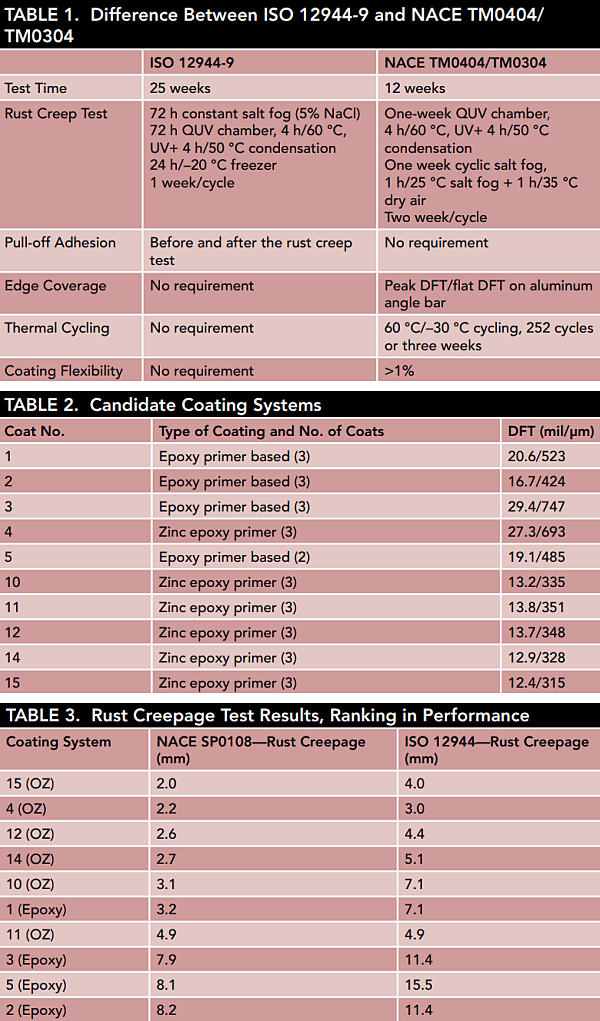The offshore environment is highly corrosive, and due to this, the service life of offshore platform coatings can be extremely short, sometimes less than eight years. When comparing the cost of new construction vs. the cost of maintenance, the maintenance cost is much pricier—coming in at an order of magnitude higher than new construction.
It is, therefore, imperative that facility owners make a coating selection that will yield the longest service life possible.
Three major causes contribute to coating failures in offshore platforms: rust creepage at the scribes/scratches damaged by tools, early coating breakdown at sharp edges and corners, and thermal cycle cracking at corners.
Causes of Coating Failures
Rust creepage, or underfilm corrosion, is a widespread problem on offshore platforms. A great deal of activity and operations take place on a regular basis, which lead to mechanical damages. These dents, scratches, and scribes damage coating and expose the metal underneath. Blisters normally form around damaged areas because the steel begins rusting and rust creepage occurs.
Early coating breakdown and holidays are common on edges, a primary localized area. Coating is typically thin along sharp edges and corners, meaning it does not provide adequate corrosion protection to the steel beneath it. In an attempt to prevent this from occurring, workers will round the edges and apply a stripe coat. Coatings with improved edge retention can aid in protecting the edges from corrosion.
Thermal cycle cracking occurs at the inner corners where coating is thicker. This is known to occur on structural I-beams and angle bars. Thicker coating causes higher residual stresses that leads to cracking due to changes in temperature between day and night. This can also happen to equipment and piping that experience temperature fluctuations due to internal fluid or the environment, causing the coating to expand and contract.
Two International Standards
To assess offshore atmospheric coatings, two reputable international standards are used—ISO and NACE. The ISO document used is ISO-12944-9; and the NACE document used is either NACE TM0404 (for new construction) or NACE TM0304 (for maintenance).
The significant differences between the standards include the cyclic test method, for which ISO requires a 25-week test and NACE requires only a 12-week test; the duration for the rust creepage test; and the NACE standard requires other coating properties. These differences are listed in Table 1.
Because these two standards differ, experts Sai P. Venkateswaran, Andy Bodington, and Tim Bieri with BP America, along with Benjamin T.A. Chang with PolyLab, endeavored to discern whether they lead to the selection of the same or a different coating. They conducted rust creepage tests according to the two standards and compared the differences on a group of maintenance coatings, then evaluated the outcomes.
New Experimental Outcomes

For the experiment, the scientists used three epoxy and seven zinc-rich epoxy coatings systems (Table 2). They tested all coating systems using the ISO 12944-9 rust creepage test, along with the NACE TM-404 test standard, thermal cycling test, and edge coverage test.
The rust creepage results show that both the NACE and ISO test can determine good and bad performers from a pool of candidates. It should be noted that results for the ISO test are always higher than the NACE test due to the longer length of time the ISO test requires.
Additionally, the two standards have different pass/fail criterion regarding rust creepage. Zinc-rich coatings will always have lower rust creepage than non-zinc coatings. Table 3 ranks the test results in accordance with their performance. Figure 1 shows the results of the NACE test (left) and ISO test (right) of the top and bottom coating performers.
The NACE thermal cycling test revealed only one coating cracked during the test. That coating showed minor cracks in the inner corners, which was observed through the use of a red dye penetrant. The NACE edge retention test concluded that not all coatings displayed good edge retention. Acceptance criterion is >50% and four coating systems fell below that threshold.
This article, repurposed from Materials Performance (MP) Magazine, is based on CORROSION 2021 paper no. 16902, presented virtually.
